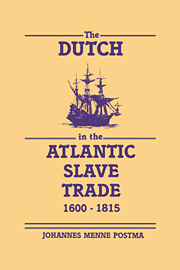Book contents
- Frontmatter
- Contents
- List of tables, figures, and maps
- Preface
- 1 Foundations of the slave traffic, 1600–61
- 2 Curaçao and the asiento trade, 1650–1730
- 3 The Dutch on the West African coast
- 4 Trade and politics on the African coast
- 5 Volume of African exports and origins of slaves
- 6 Organization and mechanics of the trade
- 7 The triangular trade
- 8 The Dutch plantation colonies under WIC monopoly, 1618–1738
- 9 The era of the free trade, 1730–80
- 10 The slaves: their treatment and mortality
- 11 Finances, marketing, and profitability
- 12 The end of the Dutch slave trade, 1781–1815
- Appendixes
- Bibliography
- Index
3 - The Dutch on the West African coast
Published online by Cambridge University Press: 16 September 2009
- Frontmatter
- Contents
- List of tables, figures, and maps
- Preface
- 1 Foundations of the slave traffic, 1600–61
- 2 Curaçao and the asiento trade, 1650–1730
- 3 The Dutch on the West African coast
- 4 Trade and politics on the African coast
- 5 Volume of African exports and origins of slaves
- 6 Organization and mechanics of the trade
- 7 The triangular trade
- 8 The Dutch plantation colonies under WIC monopoly, 1618–1738
- 9 The era of the free trade, 1730–80
- 10 The slaves: their treatment and mortality
- 11 Finances, marketing, and profitability
- 12 The end of the Dutch slave trade, 1781–1815
- Appendixes
- Bibliography
- Index
Summary
It was on the African coast that so much of this tragic chapter in human history played itself out. Here the intricacies of the Afro-European trade bargained over the fate of the slaves. And here the slaves first saw their new white masters and the mighty ocean they were to cross, and faced what must have seemed to them a mysterious and frightening future. The next few chapters will focus on Africa, essential to the understanding of the slave trade, although the European initiators and facilitators of the trade will still remain in the limelight because they also created and preserved most of the pertinent historical records. The slaves themselves will receive more attention in Chapters 7 and 10.
Commercial profit was undoubtedly the principal inducement for Europeans to live and work on the West African coast. Through commerce they might succeed in this, and the importance of trade was reflected in the European nomenclature for West Africa's coastal regions. Rather than adopting terms of African derivation, Europeans tended to name certain portions of the coast after the principal commercial items acquired in such areas. Hence, such names as Ivory Coast, Gold Coast, and Slave Coast were commonly applied to the various regions of the West African coast.
The coastal regions and the slave trade
Europeans tended to divide the western coastline of Africa into two general areas, the Guinea and the Angola coasts.
- Type
- Chapter
- Information
- The Dutch in the Atlantic Slave Trade, 1600–1815 , pp. 56 - 83Publisher: Cambridge University PressPrint publication year: 1990



